Quantitative Research on Client-Caused Variations in UAE Projects
VerifiedAdded on 2019/09/26
|32
|5544
|176
Report
AI Summary
This report presents a comprehensive quantitative research study focused on client-caused variations in construction projects within the United Arab Emirates. The methodology section outlines the research philosophy, comparing positivism and interpretivism, and justifying the selection of a mixed approach that incorporates elements of both. The research strategy primarily involves survey research, with considerations for case study and action research. The report details participant selection, sampling methods, and the use of research software and questionnaires. It addresses data validity, reliability, and research limitations, alongside ethical considerations. The core of the report lies in its main findings and interpretation of the data, followed by a discussion of the implications and recommendations for mitigating the impact of client-caused variations. The report concludes with a summary of the key insights and a list of references and appendices to support the research. The research aims to provide valuable insights into the causes of variation in construction projects and offer practical recommendations to improve project outcomes.
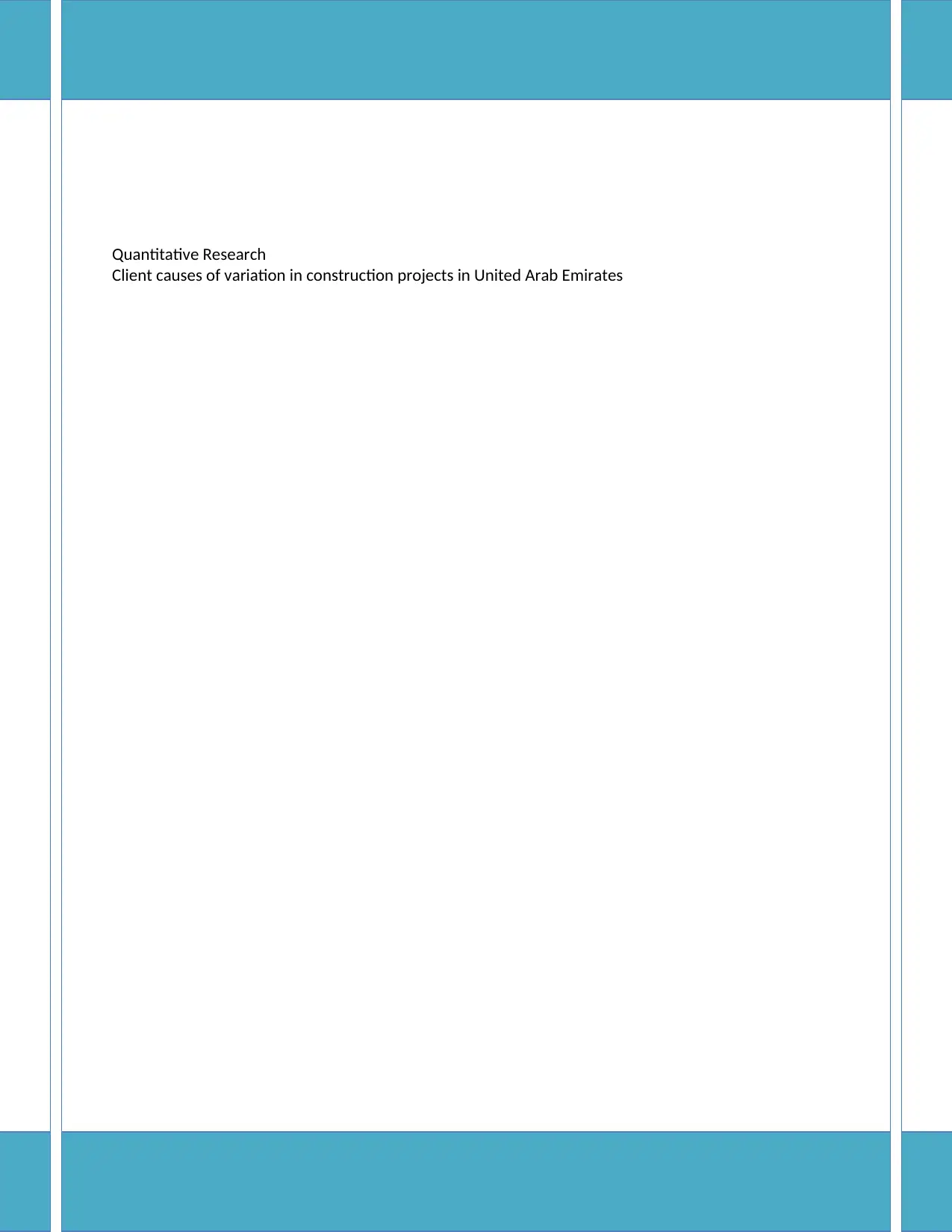
Quantitative Research
Client causes of variation in construction projects in United Arab Emirates
Client causes of variation in construction projects in United Arab Emirates
Paraphrase This Document
Need a fresh take? Get an instant paraphrase of this document with our AI Paraphraser
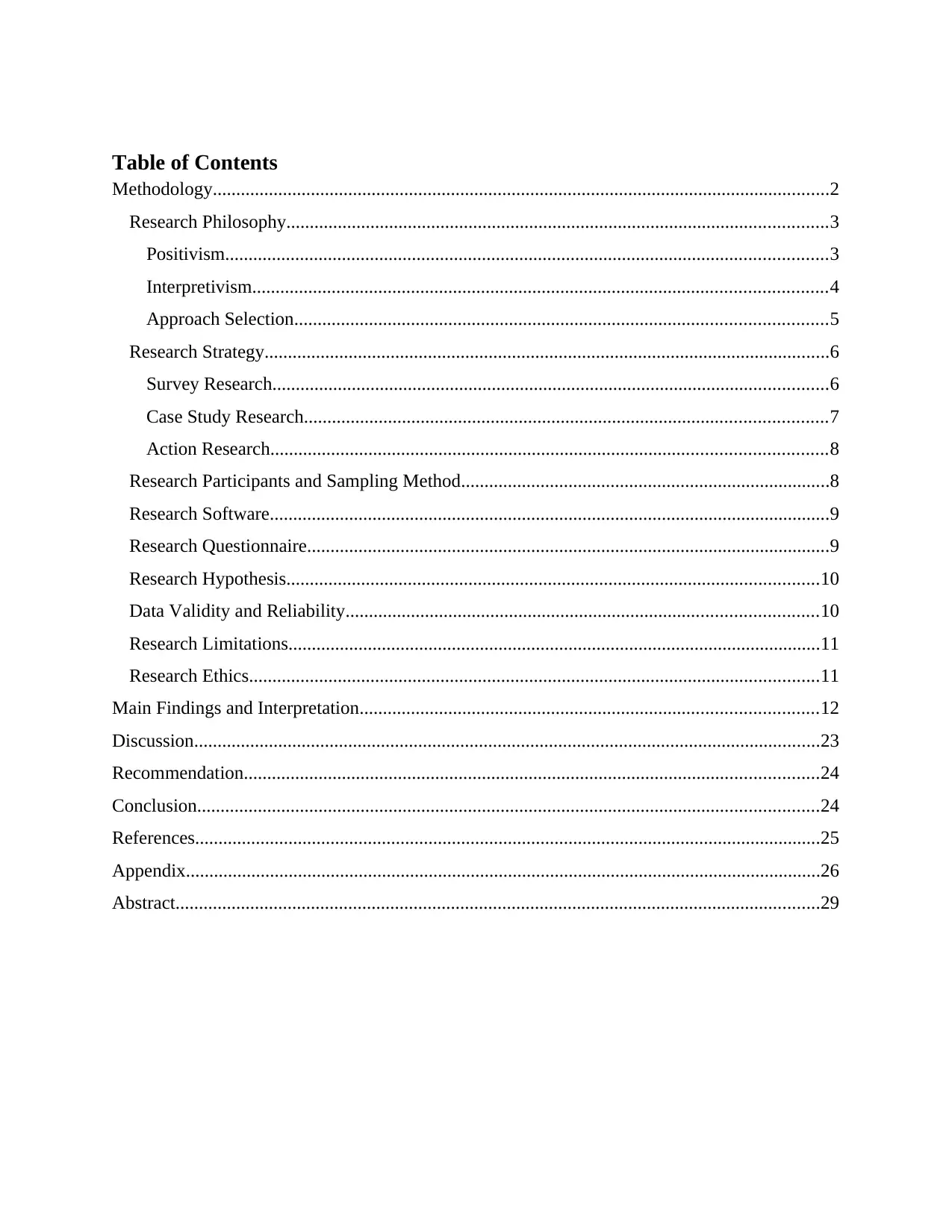
Table of Contents
Methodology....................................................................................................................................2
Research Philosophy....................................................................................................................3
Positivism.................................................................................................................................3
Interpretivism...........................................................................................................................4
Approach Selection..................................................................................................................5
Research Strategy.........................................................................................................................6
Survey Research.......................................................................................................................6
Case Study Research................................................................................................................7
Action Research.......................................................................................................................8
Research Participants and Sampling Method...............................................................................8
Research Software........................................................................................................................9
Research Questionnaire................................................................................................................9
Research Hypothesis..................................................................................................................10
Data Validity and Reliability.....................................................................................................10
Research Limitations..................................................................................................................11
Research Ethics..........................................................................................................................11
Main Findings and Interpretation..................................................................................................12
Discussion......................................................................................................................................23
Recommendation...........................................................................................................................24
Conclusion.....................................................................................................................................24
References......................................................................................................................................25
Appendix........................................................................................................................................26
Abstract..........................................................................................................................................29
Methodology....................................................................................................................................2
Research Philosophy....................................................................................................................3
Positivism.................................................................................................................................3
Interpretivism...........................................................................................................................4
Approach Selection..................................................................................................................5
Research Strategy.........................................................................................................................6
Survey Research.......................................................................................................................6
Case Study Research................................................................................................................7
Action Research.......................................................................................................................8
Research Participants and Sampling Method...............................................................................8
Research Software........................................................................................................................9
Research Questionnaire................................................................................................................9
Research Hypothesis..................................................................................................................10
Data Validity and Reliability.....................................................................................................10
Research Limitations..................................................................................................................11
Research Ethics..........................................................................................................................11
Main Findings and Interpretation..................................................................................................12
Discussion......................................................................................................................................23
Recommendation...........................................................................................................................24
Conclusion.....................................................................................................................................24
References......................................................................................................................................25
Appendix........................................................................................................................................26
Abstract..........................................................................................................................................29
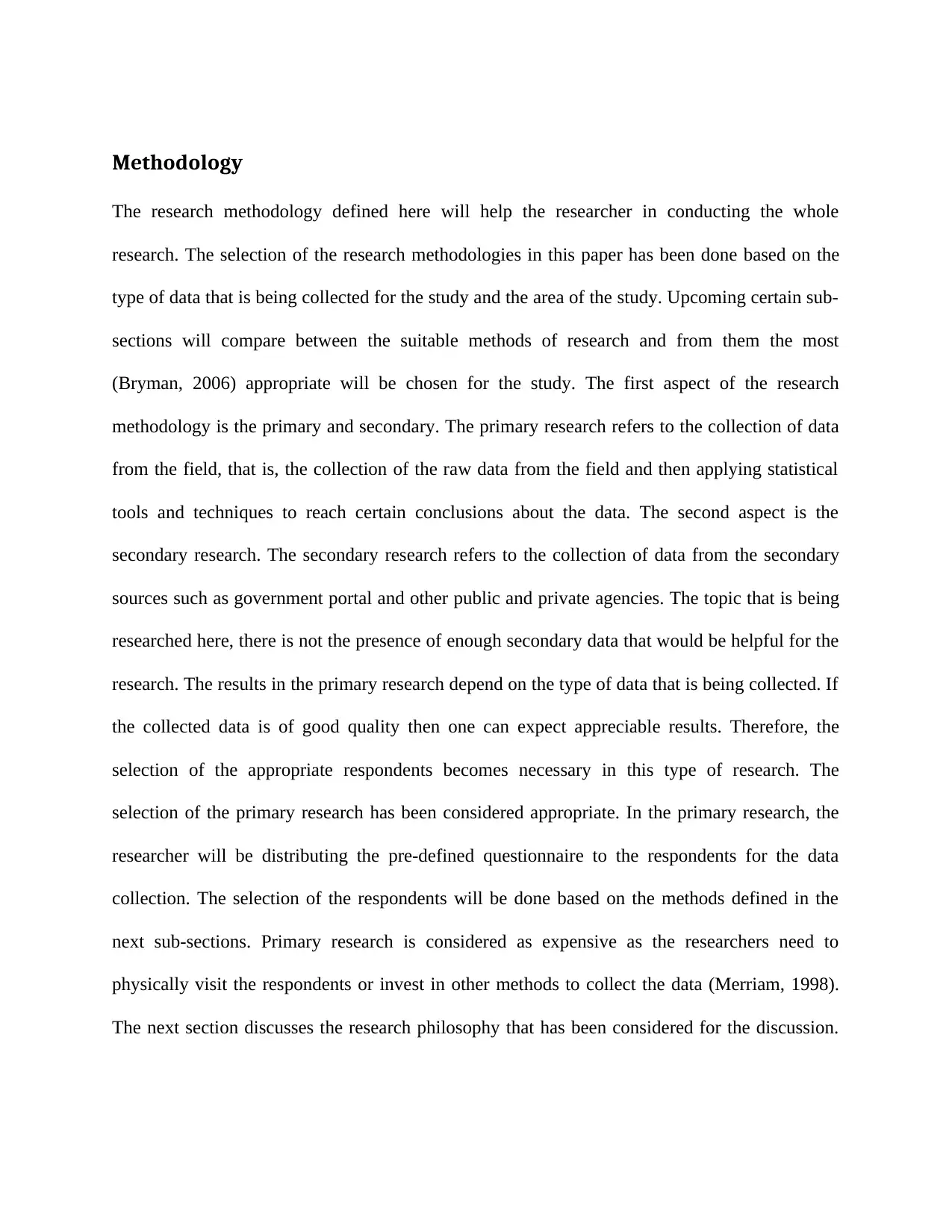
Methodology
The research methodology defined here will help the researcher in conducting the whole
research. The selection of the research methodologies in this paper has been done based on the
type of data that is being collected for the study and the area of the study. Upcoming certain sub-
sections will compare between the suitable methods of research and from them the most
(Bryman, 2006) appropriate will be chosen for the study. The first aspect of the research
methodology is the primary and secondary. The primary research refers to the collection of data
from the field, that is, the collection of the raw data from the field and then applying statistical
tools and techniques to reach certain conclusions about the data. The second aspect is the
secondary research. The secondary research refers to the collection of data from the secondary
sources such as government portal and other public and private agencies. The topic that is being
researched here, there is not the presence of enough secondary data that would be helpful for the
research. The results in the primary research depend on the type of data that is being collected. If
the collected data is of good quality then one can expect appreciable results. Therefore, the
selection of the appropriate respondents becomes necessary in this type of research. The
selection of the primary research has been considered appropriate. In the primary research, the
researcher will be distributing the pre-defined questionnaire to the respondents for the data
collection. The selection of the respondents will be done based on the methods defined in the
next sub-sections. Primary research is considered as expensive as the researchers need to
physically visit the respondents or invest in other methods to collect the data (Merriam, 1998).
The next section discusses the research philosophy that has been considered for the discussion.
The research methodology defined here will help the researcher in conducting the whole
research. The selection of the research methodologies in this paper has been done based on the
type of data that is being collected for the study and the area of the study. Upcoming certain sub-
sections will compare between the suitable methods of research and from them the most
(Bryman, 2006) appropriate will be chosen for the study. The first aspect of the research
methodology is the primary and secondary. The primary research refers to the collection of data
from the field, that is, the collection of the raw data from the field and then applying statistical
tools and techniques to reach certain conclusions about the data. The second aspect is the
secondary research. The secondary research refers to the collection of data from the secondary
sources such as government portal and other public and private agencies. The topic that is being
researched here, there is not the presence of enough secondary data that would be helpful for the
research. The results in the primary research depend on the type of data that is being collected. If
the collected data is of good quality then one can expect appreciable results. Therefore, the
selection of the appropriate respondents becomes necessary in this type of research. The
selection of the primary research has been considered appropriate. In the primary research, the
researcher will be distributing the pre-defined questionnaire to the respondents for the data
collection. The selection of the respondents will be done based on the methods defined in the
next sub-sections. Primary research is considered as expensive as the researchers need to
physically visit the respondents or invest in other methods to collect the data (Merriam, 1998).
The next section discusses the research philosophy that has been considered for the discussion.
⊘ This is a preview!⊘
Do you want full access?
Subscribe today to unlock all pages.

Trusted by 1+ million students worldwide
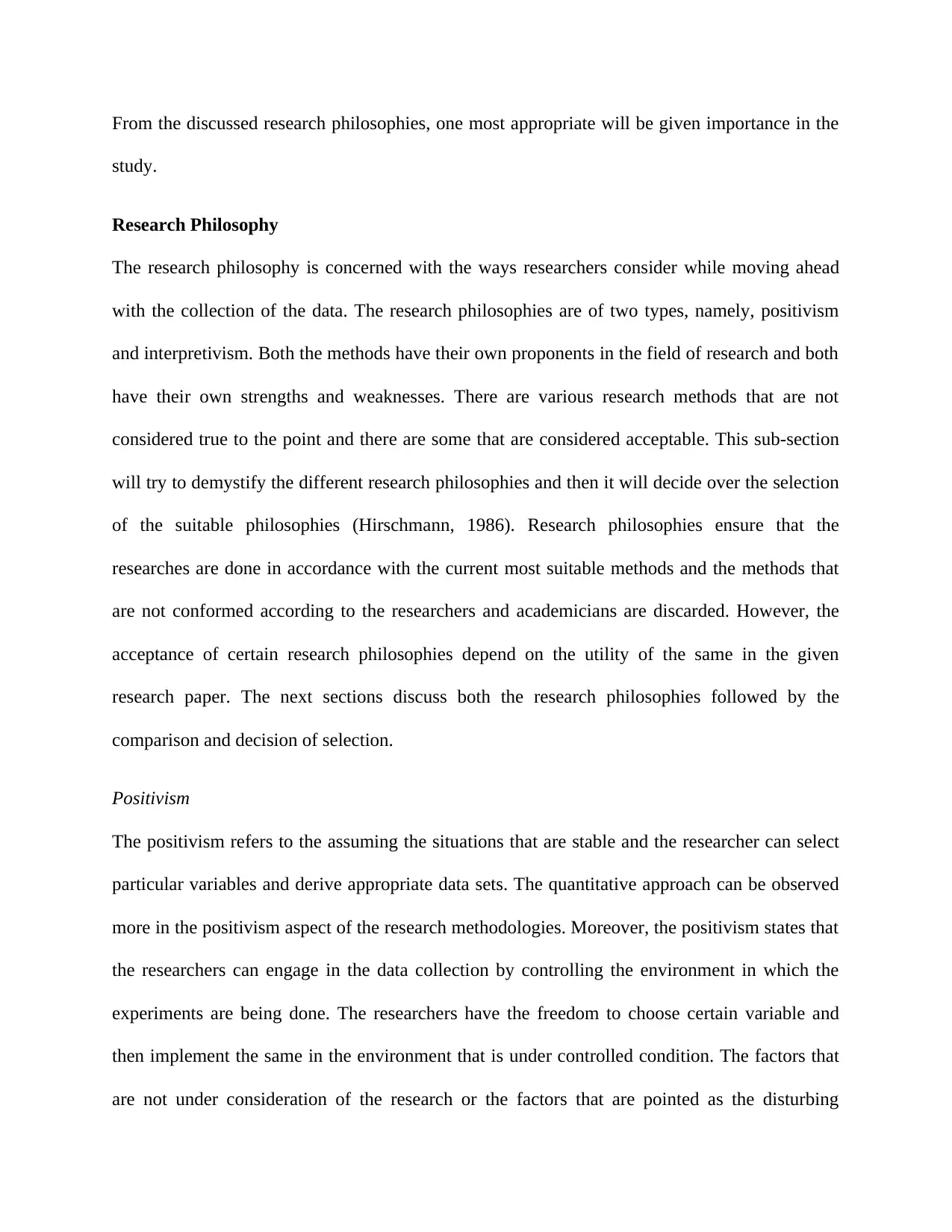
From the discussed research philosophies, one most appropriate will be given importance in the
study.
Research Philosophy
The research philosophy is concerned with the ways researchers consider while moving ahead
with the collection of the data. The research philosophies are of two types, namely, positivism
and interpretivism. Both the methods have their own proponents in the field of research and both
have their own strengths and weaknesses. There are various research methods that are not
considered true to the point and there are some that are considered acceptable. This sub-section
will try to demystify the different research philosophies and then it will decide over the selection
of the suitable philosophies (Hirschmann, 1986). Research philosophies ensure that the
researches are done in accordance with the current most suitable methods and the methods that
are not conformed according to the researchers and academicians are discarded. However, the
acceptance of certain research philosophies depend on the utility of the same in the given
research paper. The next sections discuss both the research philosophies followed by the
comparison and decision of selection.
Positivism
The positivism refers to the assuming the situations that are stable and the researcher can select
particular variables and derive appropriate data sets. The quantitative approach can be observed
more in the positivism aspect of the research methodologies. Moreover, the positivism states that
the researchers can engage in the data collection by controlling the environment in which the
experiments are being done. The researchers have the freedom to choose certain variable and
then implement the same in the environment that is under controlled condition. The factors that
are not under consideration of the research or the factors that are pointed as the disturbing
study.
Research Philosophy
The research philosophy is concerned with the ways researchers consider while moving ahead
with the collection of the data. The research philosophies are of two types, namely, positivism
and interpretivism. Both the methods have their own proponents in the field of research and both
have their own strengths and weaknesses. There are various research methods that are not
considered true to the point and there are some that are considered acceptable. This sub-section
will try to demystify the different research philosophies and then it will decide over the selection
of the suitable philosophies (Hirschmann, 1986). Research philosophies ensure that the
researches are done in accordance with the current most suitable methods and the methods that
are not conformed according to the researchers and academicians are discarded. However, the
acceptance of certain research philosophies depend on the utility of the same in the given
research paper. The next sections discuss both the research philosophies followed by the
comparison and decision of selection.
Positivism
The positivism refers to the assuming the situations that are stable and the researcher can select
particular variables and derive appropriate data sets. The quantitative approach can be observed
more in the positivism aspect of the research methodologies. Moreover, the positivism states that
the researchers can engage in the data collection by controlling the environment in which the
experiments are being done. The researchers have the freedom to choose certain variable and
then implement the same in the environment that is under controlled condition. The factors that
are not under consideration of the research or the factors that are pointed as the disturbing
Paraphrase This Document
Need a fresh take? Get an instant paraphrase of this document with our AI Paraphraser
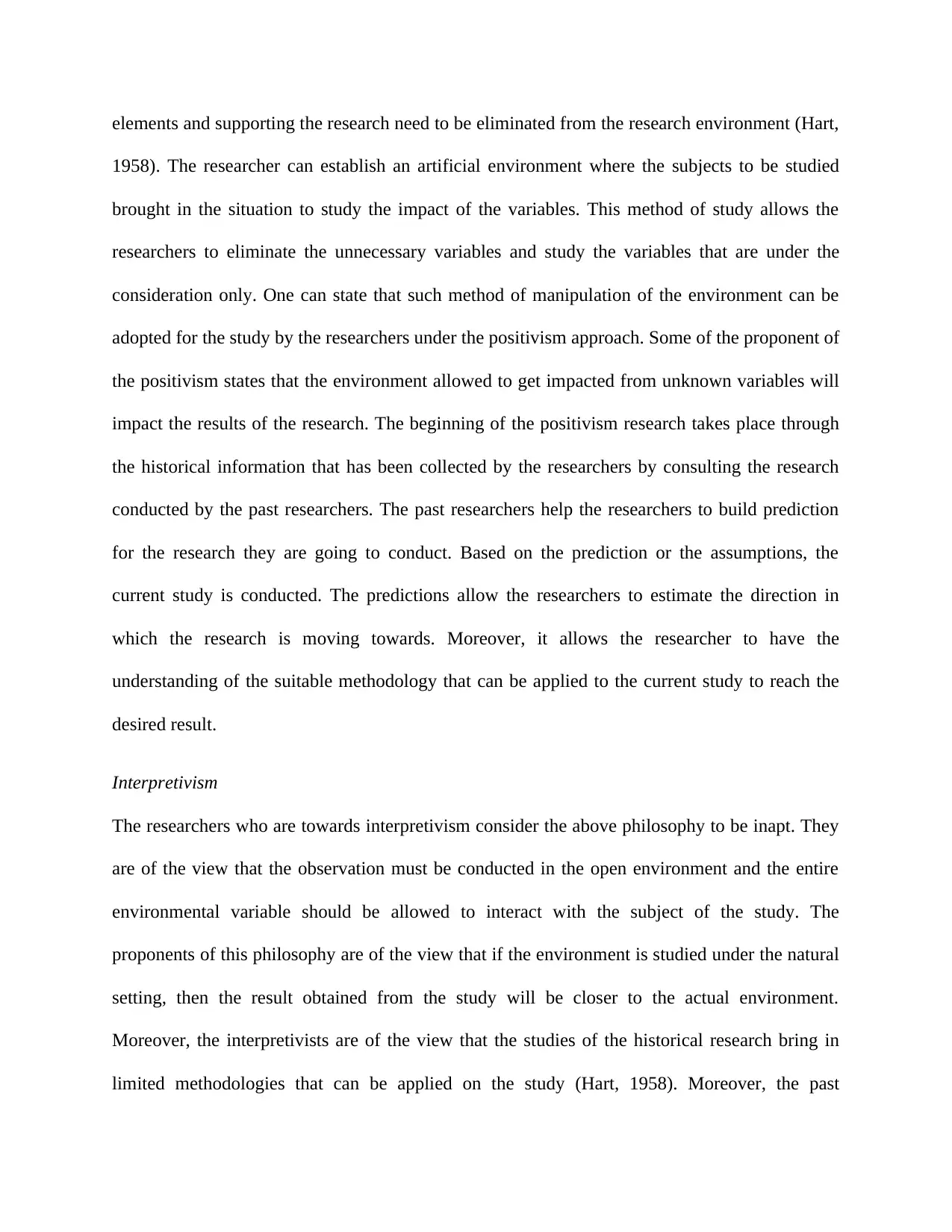
elements and supporting the research need to be eliminated from the research environment (Hart,
1958). The researcher can establish an artificial environment where the subjects to be studied
brought in the situation to study the impact of the variables. This method of study allows the
researchers to eliminate the unnecessary variables and study the variables that are under the
consideration only. One can state that such method of manipulation of the environment can be
adopted for the study by the researchers under the positivism approach. Some of the proponent of
the positivism states that the environment allowed to get impacted from unknown variables will
impact the results of the research. The beginning of the positivism research takes place through
the historical information that has been collected by the researchers by consulting the research
conducted by the past researchers. The past researchers help the researchers to build prediction
for the research they are going to conduct. Based on the prediction or the assumptions, the
current study is conducted. The predictions allow the researchers to estimate the direction in
which the research is moving towards. Moreover, it allows the researcher to have the
understanding of the suitable methodology that can be applied to the current study to reach the
desired result.
Interpretivism
The researchers who are towards interpretivism consider the above philosophy to be inapt. They
are of the view that the observation must be conducted in the open environment and the entire
environmental variable should be allowed to interact with the subject of the study. The
proponents of this philosophy are of the view that if the environment is studied under the natural
setting, then the result obtained from the study will be closer to the actual environment.
Moreover, the interpretivists are of the view that the studies of the historical research bring in
limited methodologies that can be applied on the study (Hart, 1958). Moreover, the past
1958). The researcher can establish an artificial environment where the subjects to be studied
brought in the situation to study the impact of the variables. This method of study allows the
researchers to eliminate the unnecessary variables and study the variables that are under the
consideration only. One can state that such method of manipulation of the environment can be
adopted for the study by the researchers under the positivism approach. Some of the proponent of
the positivism states that the environment allowed to get impacted from unknown variables will
impact the results of the research. The beginning of the positivism research takes place through
the historical information that has been collected by the researchers by consulting the research
conducted by the past researchers. The past researchers help the researchers to build prediction
for the research they are going to conduct. Based on the prediction or the assumptions, the
current study is conducted. The predictions allow the researchers to estimate the direction in
which the research is moving towards. Moreover, it allows the researcher to have the
understanding of the suitable methodology that can be applied to the current study to reach the
desired result.
Interpretivism
The researchers who are towards interpretivism consider the above philosophy to be inapt. They
are of the view that the observation must be conducted in the open environment and the entire
environmental variable should be allowed to interact with the subject of the study. The
proponents of this philosophy are of the view that if the environment is studied under the natural
setting, then the result obtained from the study will be closer to the actual environment.
Moreover, the interpretivists are of the view that the studies of the historical research bring in
limited methodologies that can be applied on the study (Hart, 1958). Moreover, the past
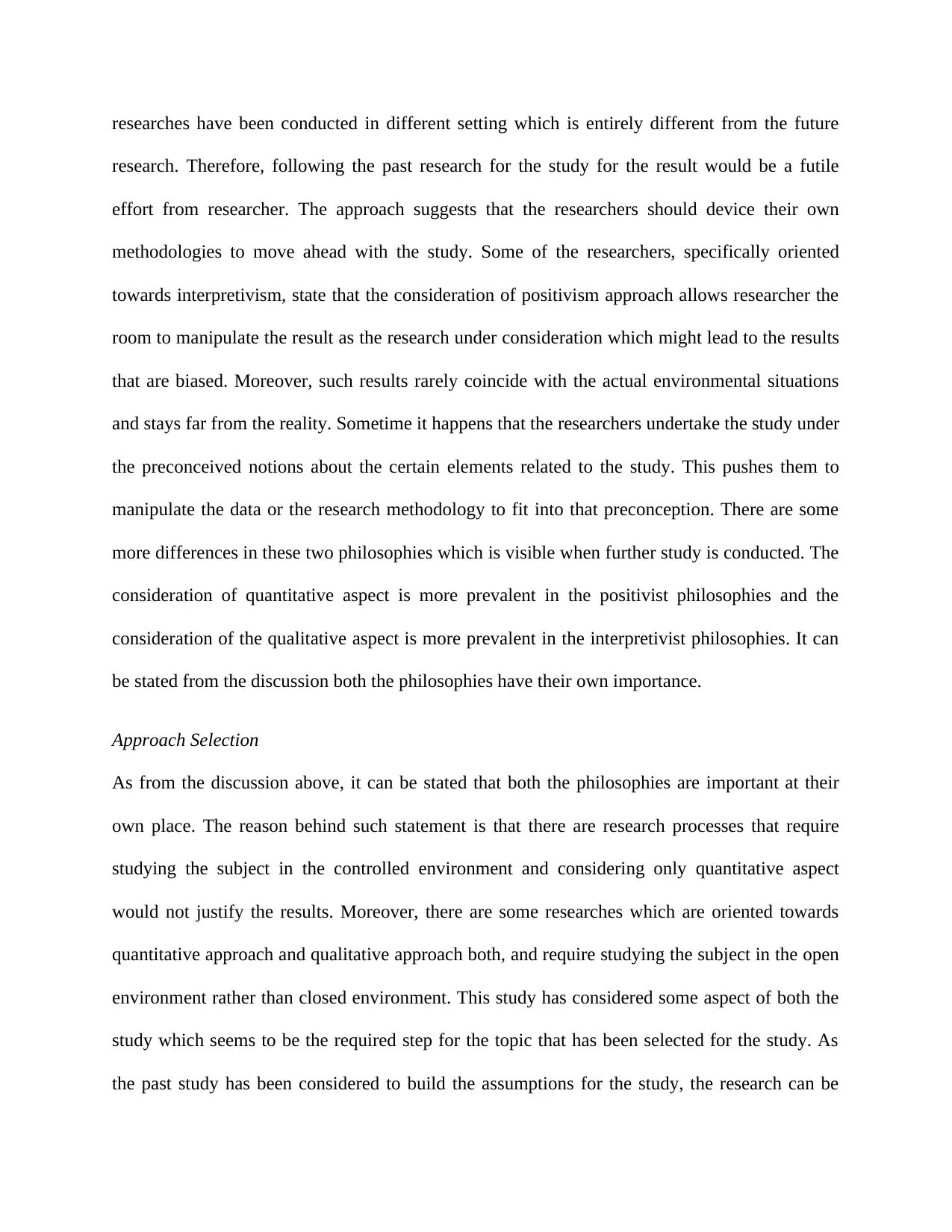
researches have been conducted in different setting which is entirely different from the future
research. Therefore, following the past research for the study for the result would be a futile
effort from researcher. The approach suggests that the researchers should device their own
methodologies to move ahead with the study. Some of the researchers, specifically oriented
towards interpretivism, state that the consideration of positivism approach allows researcher the
room to manipulate the result as the research under consideration which might lead to the results
that are biased. Moreover, such results rarely coincide with the actual environmental situations
and stays far from the reality. Sometime it happens that the researchers undertake the study under
the preconceived notions about the certain elements related to the study. This pushes them to
manipulate the data or the research methodology to fit into that preconception. There are some
more differences in these two philosophies which is visible when further study is conducted. The
consideration of quantitative aspect is more prevalent in the positivist philosophies and the
consideration of the qualitative aspect is more prevalent in the interpretivist philosophies. It can
be stated from the discussion both the philosophies have their own importance.
Approach Selection
As from the discussion above, it can be stated that both the philosophies are important at their
own place. The reason behind such statement is that there are research processes that require
studying the subject in the controlled environment and considering only quantitative aspect
would not justify the results. Moreover, there are some researches which are oriented towards
quantitative approach and qualitative approach both, and require studying the subject in the open
environment rather than closed environment. This study has considered some aspect of both the
study which seems to be the required step for the topic that has been selected for the study. As
the past study has been considered to build the assumptions for the study, the research can be
research. Therefore, following the past research for the study for the result would be a futile
effort from researcher. The approach suggests that the researchers should device their own
methodologies to move ahead with the study. Some of the researchers, specifically oriented
towards interpretivism, state that the consideration of positivism approach allows researcher the
room to manipulate the result as the research under consideration which might lead to the results
that are biased. Moreover, such results rarely coincide with the actual environmental situations
and stays far from the reality. Sometime it happens that the researchers undertake the study under
the preconceived notions about the certain elements related to the study. This pushes them to
manipulate the data or the research methodology to fit into that preconception. There are some
more differences in these two philosophies which is visible when further study is conducted. The
consideration of quantitative aspect is more prevalent in the positivist philosophies and the
consideration of the qualitative aspect is more prevalent in the interpretivist philosophies. It can
be stated from the discussion both the philosophies have their own importance.
Approach Selection
As from the discussion above, it can be stated that both the philosophies are important at their
own place. The reason behind such statement is that there are research processes that require
studying the subject in the controlled environment and considering only quantitative aspect
would not justify the results. Moreover, there are some researches which are oriented towards
quantitative approach and qualitative approach both, and require studying the subject in the open
environment rather than closed environment. This study has considered some aspect of both the
study which seems to be the required step for the topic that has been selected for the study. As
the past study has been considered to build the assumptions for the study, the research can be
⊘ This is a preview!⊘
Do you want full access?
Subscribe today to unlock all pages.

Trusted by 1+ million students worldwide
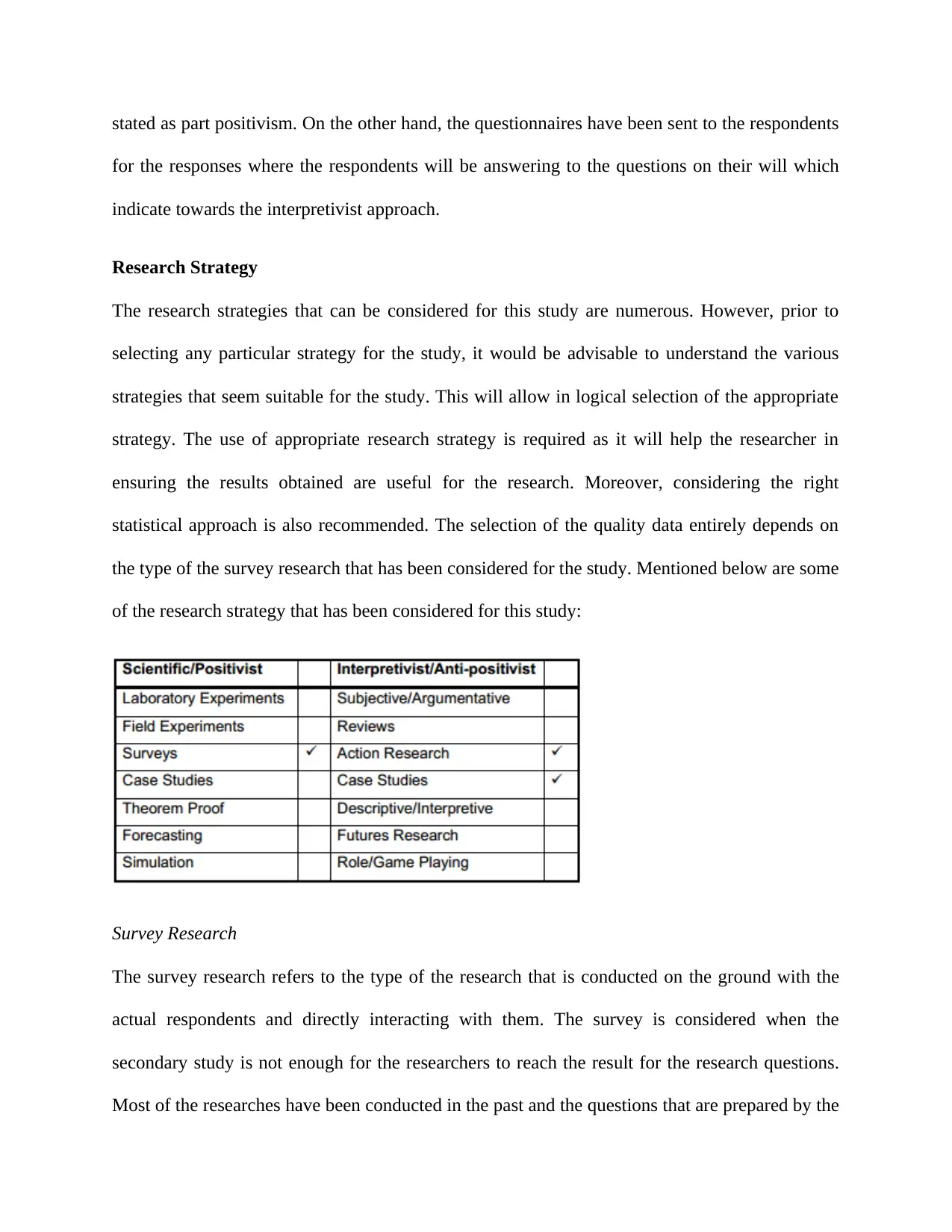
stated as part positivism. On the other hand, the questionnaires have been sent to the respondents
for the responses where the respondents will be answering to the questions on their will which
indicate towards the interpretivist approach.
Research Strategy
The research strategies that can be considered for this study are numerous. However, prior to
selecting any particular strategy for the study, it would be advisable to understand the various
strategies that seem suitable for the study. This will allow in logical selection of the appropriate
strategy. The use of appropriate research strategy is required as it will help the researcher in
ensuring the results obtained are useful for the research. Moreover, considering the right
statistical approach is also recommended. The selection of the quality data entirely depends on
the type of the survey research that has been considered for the study. Mentioned below are some
of the research strategy that has been considered for this study:
Survey Research
The survey research refers to the type of the research that is conducted on the ground with the
actual respondents and directly interacting with them. The survey is considered when the
secondary study is not enough for the researchers to reach the result for the research questions.
Most of the researches have been conducted in the past and the questions that are prepared by the
for the responses where the respondents will be answering to the questions on their will which
indicate towards the interpretivist approach.
Research Strategy
The research strategies that can be considered for this study are numerous. However, prior to
selecting any particular strategy for the study, it would be advisable to understand the various
strategies that seem suitable for the study. This will allow in logical selection of the appropriate
strategy. The use of appropriate research strategy is required as it will help the researcher in
ensuring the results obtained are useful for the research. Moreover, considering the right
statistical approach is also recommended. The selection of the quality data entirely depends on
the type of the survey research that has been considered for the study. Mentioned below are some
of the research strategy that has been considered for this study:
Survey Research
The survey research refers to the type of the research that is conducted on the ground with the
actual respondents and directly interacting with them. The survey is considered when the
secondary study is not enough for the researchers to reach the result for the research questions.
Most of the researches have been conducted in the past and the questions that are prepared by the
Paraphrase This Document
Need a fresh take? Get an instant paraphrase of this document with our AI Paraphraser
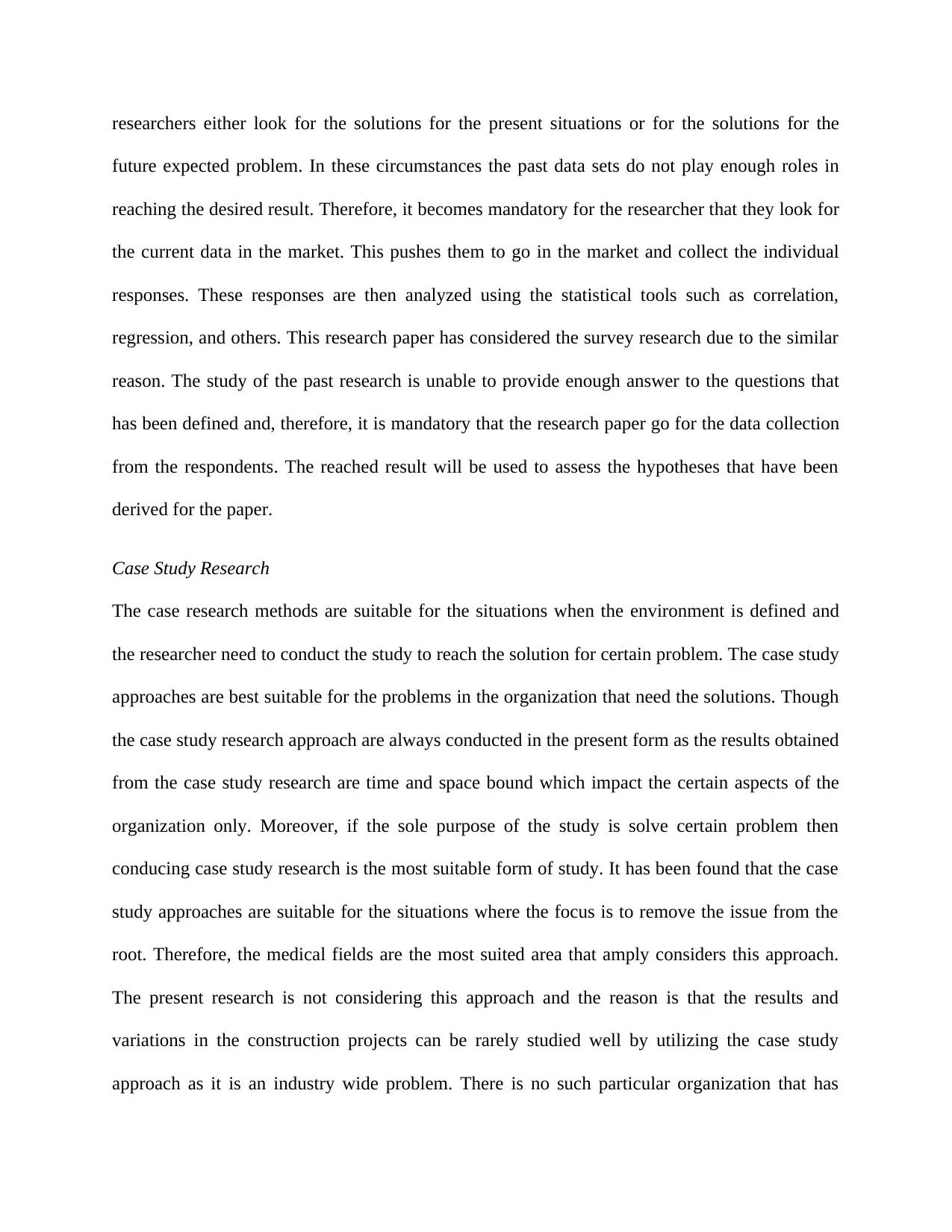
researchers either look for the solutions for the present situations or for the solutions for the
future expected problem. In these circumstances the past data sets do not play enough roles in
reaching the desired result. Therefore, it becomes mandatory for the researcher that they look for
the current data in the market. This pushes them to go in the market and collect the individual
responses. These responses are then analyzed using the statistical tools such as correlation,
regression, and others. This research paper has considered the survey research due to the similar
reason. The study of the past research is unable to provide enough answer to the questions that
has been defined and, therefore, it is mandatory that the research paper go for the data collection
from the respondents. The reached result will be used to assess the hypotheses that have been
derived for the paper.
Case Study Research
The case research methods are suitable for the situations when the environment is defined and
the researcher need to conduct the study to reach the solution for certain problem. The case study
approaches are best suitable for the problems in the organization that need the solutions. Though
the case study research approach are always conducted in the present form as the results obtained
from the case study research are time and space bound which impact the certain aspects of the
organization only. Moreover, if the sole purpose of the study is solve certain problem then
conducing case study research is the most suitable form of study. It has been found that the case
study approaches are suitable for the situations where the focus is to remove the issue from the
root. Therefore, the medical fields are the most suited area that amply considers this approach.
The present research is not considering this approach and the reason is that the results and
variations in the construction projects can be rarely studied well by utilizing the case study
approach as it is an industry wide problem. There is no such particular organization that has
future expected problem. In these circumstances the past data sets do not play enough roles in
reaching the desired result. Therefore, it becomes mandatory for the researcher that they look for
the current data in the market. This pushes them to go in the market and collect the individual
responses. These responses are then analyzed using the statistical tools such as correlation,
regression, and others. This research paper has considered the survey research due to the similar
reason. The study of the past research is unable to provide enough answer to the questions that
has been defined and, therefore, it is mandatory that the research paper go for the data collection
from the respondents. The reached result will be used to assess the hypotheses that have been
derived for the paper.
Case Study Research
The case research methods are suitable for the situations when the environment is defined and
the researcher need to conduct the study to reach the solution for certain problem. The case study
approaches are best suitable for the problems in the organization that need the solutions. Though
the case study research approach are always conducted in the present form as the results obtained
from the case study research are time and space bound which impact the certain aspects of the
organization only. Moreover, if the sole purpose of the study is solve certain problem then
conducing case study research is the most suitable form of study. It has been found that the case
study approaches are suitable for the situations where the focus is to remove the issue from the
root. Therefore, the medical fields are the most suited area that amply considers this approach.
The present research is not considering this approach and the reason is that the results and
variations in the construction projects can be rarely studied well by utilizing the case study
approach as it is an industry wide problem. There is no such particular organization that has
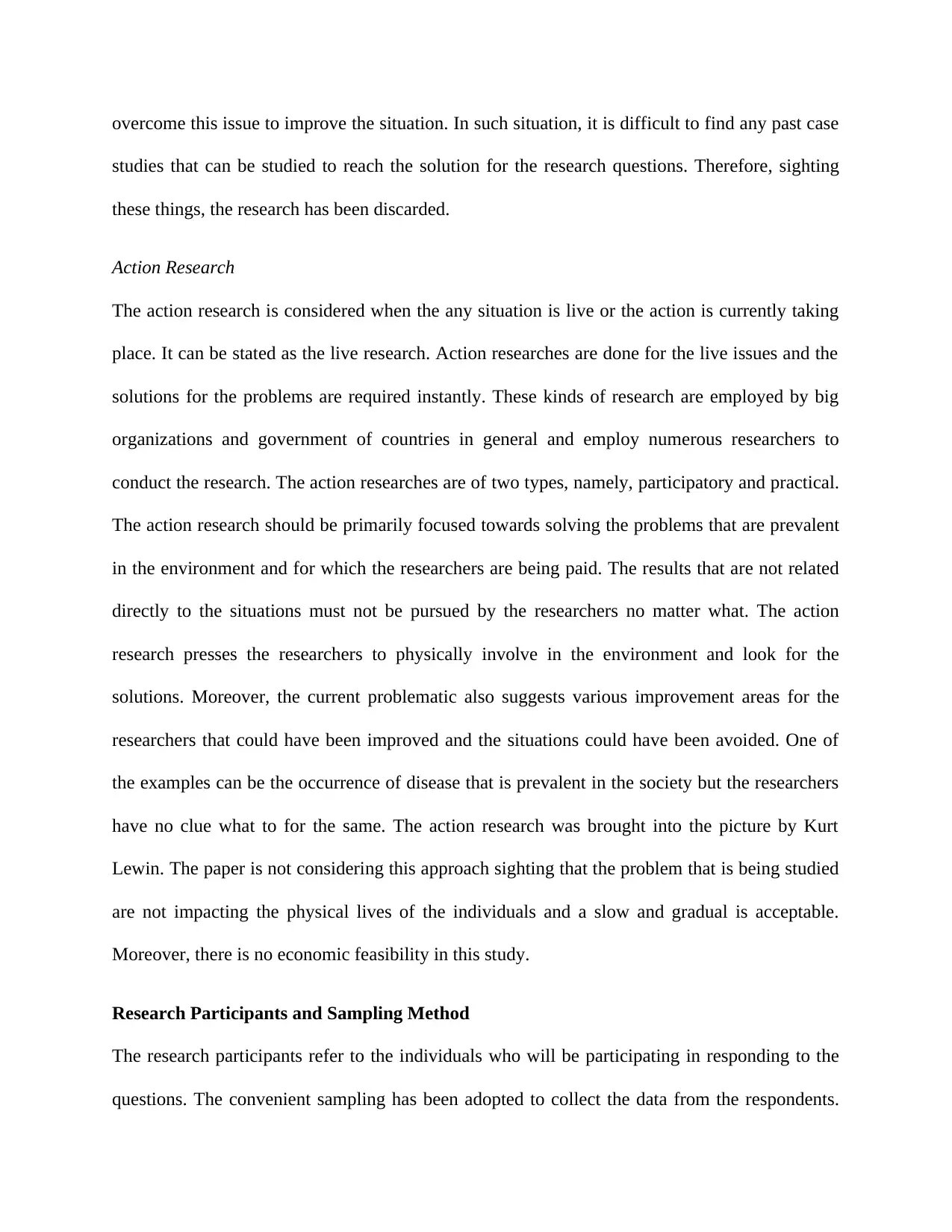
overcome this issue to improve the situation. In such situation, it is difficult to find any past case
studies that can be studied to reach the solution for the research questions. Therefore, sighting
these things, the research has been discarded.
Action Research
The action research is considered when the any situation is live or the action is currently taking
place. It can be stated as the live research. Action researches are done for the live issues and the
solutions for the problems are required instantly. These kinds of research are employed by big
organizations and government of countries in general and employ numerous researchers to
conduct the research. The action researches are of two types, namely, participatory and practical.
The action research should be primarily focused towards solving the problems that are prevalent
in the environment and for which the researchers are being paid. The results that are not related
directly to the situations must not be pursued by the researchers no matter what. The action
research presses the researchers to physically involve in the environment and look for the
solutions. Moreover, the current problematic also suggests various improvement areas for the
researchers that could have been improved and the situations could have been avoided. One of
the examples can be the occurrence of disease that is prevalent in the society but the researchers
have no clue what to for the same. The action research was brought into the picture by Kurt
Lewin. The paper is not considering this approach sighting that the problem that is being studied
are not impacting the physical lives of the individuals and a slow and gradual is acceptable.
Moreover, there is no economic feasibility in this study.
Research Participants and Sampling Method
The research participants refer to the individuals who will be participating in responding to the
questions. The convenient sampling has been adopted to collect the data from the respondents.
studies that can be studied to reach the solution for the research questions. Therefore, sighting
these things, the research has been discarded.
Action Research
The action research is considered when the any situation is live or the action is currently taking
place. It can be stated as the live research. Action researches are done for the live issues and the
solutions for the problems are required instantly. These kinds of research are employed by big
organizations and government of countries in general and employ numerous researchers to
conduct the research. The action researches are of two types, namely, participatory and practical.
The action research should be primarily focused towards solving the problems that are prevalent
in the environment and for which the researchers are being paid. The results that are not related
directly to the situations must not be pursued by the researchers no matter what. The action
research presses the researchers to physically involve in the environment and look for the
solutions. Moreover, the current problematic also suggests various improvement areas for the
researchers that could have been improved and the situations could have been avoided. One of
the examples can be the occurrence of disease that is prevalent in the society but the researchers
have no clue what to for the same. The action research was brought into the picture by Kurt
Lewin. The paper is not considering this approach sighting that the problem that is being studied
are not impacting the physical lives of the individuals and a slow and gradual is acceptable.
Moreover, there is no economic feasibility in this study.
Research Participants and Sampling Method
The research participants refer to the individuals who will be participating in responding to the
questions. The convenient sampling has been adopted to collect the data from the respondents.
⊘ This is a preview!⊘
Do you want full access?
Subscribe today to unlock all pages.

Trusted by 1+ million students worldwide
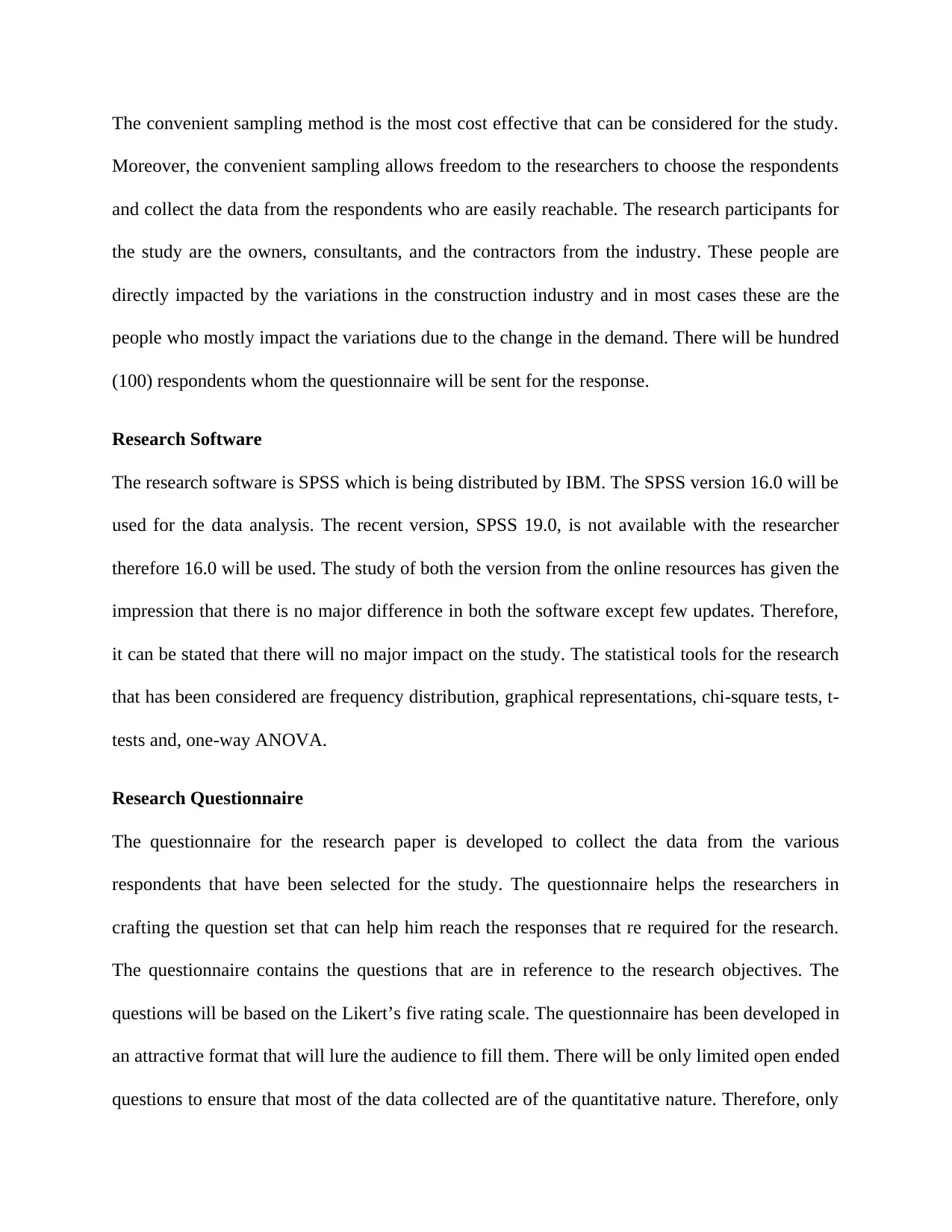
The convenient sampling method is the most cost effective that can be considered for the study.
Moreover, the convenient sampling allows freedom to the researchers to choose the respondents
and collect the data from the respondents who are easily reachable. The research participants for
the study are the owners, consultants, and the contractors from the industry. These people are
directly impacted by the variations in the construction industry and in most cases these are the
people who mostly impact the variations due to the change in the demand. There will be hundred
(100) respondents whom the questionnaire will be sent for the response.
Research Software
The research software is SPSS which is being distributed by IBM. The SPSS version 16.0 will be
used for the data analysis. The recent version, SPSS 19.0, is not available with the researcher
therefore 16.0 will be used. The study of both the version from the online resources has given the
impression that there is no major difference in both the software except few updates. Therefore,
it can be stated that there will no major impact on the study. The statistical tools for the research
that has been considered are frequency distribution, graphical representations, chi-square tests, t-
tests and, one-way ANOVA.
Research Questionnaire
The questionnaire for the research paper is developed to collect the data from the various
respondents that have been selected for the study. The questionnaire helps the researchers in
crafting the question set that can help him reach the responses that re required for the research.
The questionnaire contains the questions that are in reference to the research objectives. The
questions will be based on the Likert’s five rating scale. The questionnaire has been developed in
an attractive format that will lure the audience to fill them. There will be only limited open ended
questions to ensure that most of the data collected are of the quantitative nature. Therefore, only
Moreover, the convenient sampling allows freedom to the researchers to choose the respondents
and collect the data from the respondents who are easily reachable. The research participants for
the study are the owners, consultants, and the contractors from the industry. These people are
directly impacted by the variations in the construction industry and in most cases these are the
people who mostly impact the variations due to the change in the demand. There will be hundred
(100) respondents whom the questionnaire will be sent for the response.
Research Software
The research software is SPSS which is being distributed by IBM. The SPSS version 16.0 will be
used for the data analysis. The recent version, SPSS 19.0, is not available with the researcher
therefore 16.0 will be used. The study of both the version from the online resources has given the
impression that there is no major difference in both the software except few updates. Therefore,
it can be stated that there will no major impact on the study. The statistical tools for the research
that has been considered are frequency distribution, graphical representations, chi-square tests, t-
tests and, one-way ANOVA.
Research Questionnaire
The questionnaire for the research paper is developed to collect the data from the various
respondents that have been selected for the study. The questionnaire helps the researchers in
crafting the question set that can help him reach the responses that re required for the research.
The questionnaire contains the questions that are in reference to the research objectives. The
questions will be based on the Likert’s five rating scale. The questionnaire has been developed in
an attractive format that will lure the audience to fill them. There will be only limited open ended
questions to ensure that most of the data collected are of the quantitative nature. Therefore, only
Paraphrase This Document
Need a fresh take? Get an instant paraphrase of this document with our AI Paraphraser
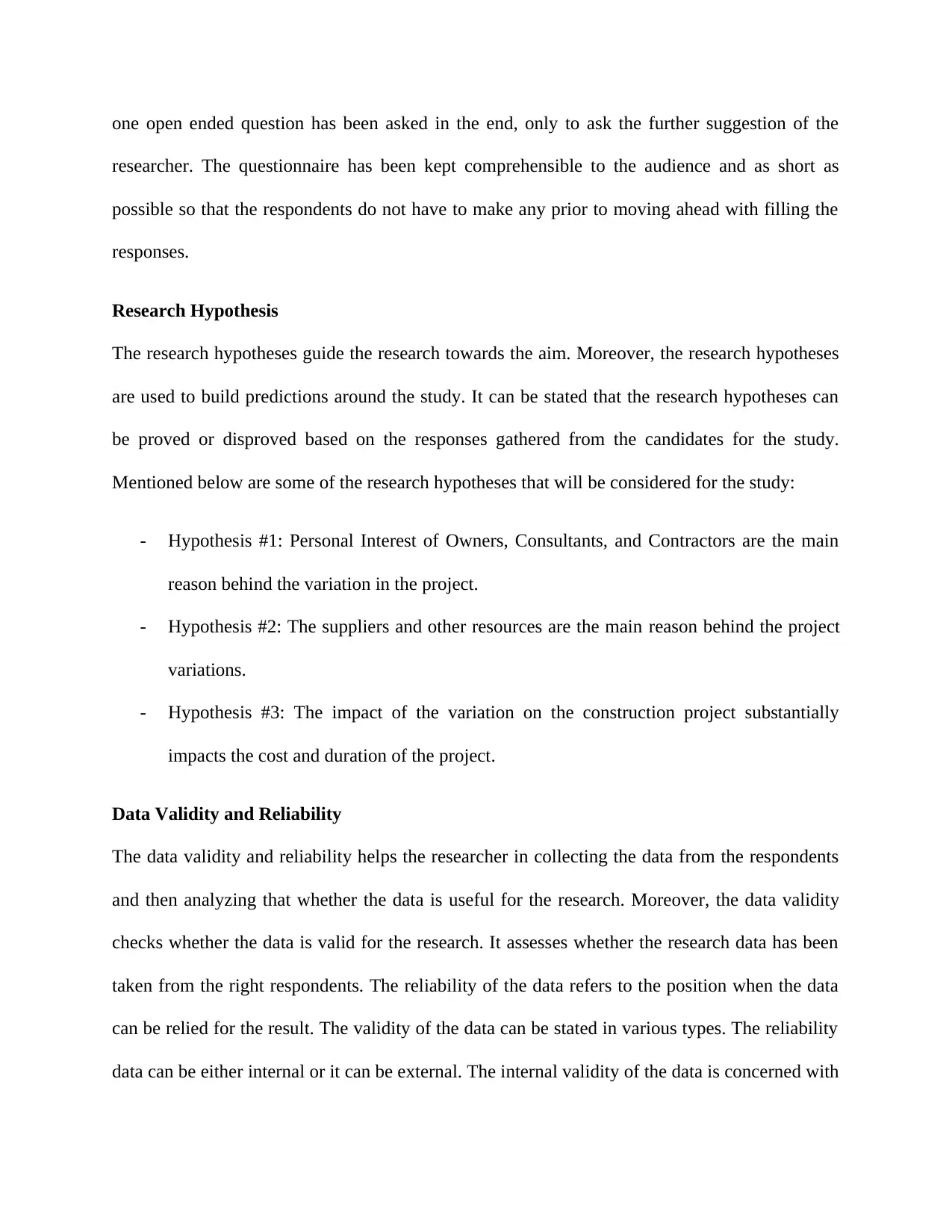
one open ended question has been asked in the end, only to ask the further suggestion of the
researcher. The questionnaire has been kept comprehensible to the audience and as short as
possible so that the respondents do not have to make any prior to moving ahead with filling the
responses.
Research Hypothesis
The research hypotheses guide the research towards the aim. Moreover, the research hypotheses
are used to build predictions around the study. It can be stated that the research hypotheses can
be proved or disproved based on the responses gathered from the candidates for the study.
Mentioned below are some of the research hypotheses that will be considered for the study:
- Hypothesis #1: Personal Interest of Owners, Consultants, and Contractors are the main
reason behind the variation in the project.
- Hypothesis #2: The suppliers and other resources are the main reason behind the project
variations.
- Hypothesis #3: The impact of the variation on the construction project substantially
impacts the cost and duration of the project.
Data Validity and Reliability
The data validity and reliability helps the researcher in collecting the data from the respondents
and then analyzing that whether the data is useful for the research. Moreover, the data validity
checks whether the data is valid for the research. It assesses whether the research data has been
taken from the right respondents. The reliability of the data refers to the position when the data
can be relied for the result. The validity of the data can be stated in various types. The reliability
data can be either internal or it can be external. The internal validity of the data is concerned with
researcher. The questionnaire has been kept comprehensible to the audience and as short as
possible so that the respondents do not have to make any prior to moving ahead with filling the
responses.
Research Hypothesis
The research hypotheses guide the research towards the aim. Moreover, the research hypotheses
are used to build predictions around the study. It can be stated that the research hypotheses can
be proved or disproved based on the responses gathered from the candidates for the study.
Mentioned below are some of the research hypotheses that will be considered for the study:
- Hypothesis #1: Personal Interest of Owners, Consultants, and Contractors are the main
reason behind the variation in the project.
- Hypothesis #2: The suppliers and other resources are the main reason behind the project
variations.
- Hypothesis #3: The impact of the variation on the construction project substantially
impacts the cost and duration of the project.
Data Validity and Reliability
The data validity and reliability helps the researcher in collecting the data from the respondents
and then analyzing that whether the data is useful for the research. Moreover, the data validity
checks whether the data is valid for the research. It assesses whether the research data has been
taken from the right respondents. The reliability of the data refers to the position when the data
can be relied for the result. The validity of the data can be stated in various types. The reliability
data can be either internal or it can be external. The internal validity of the data is concerned with
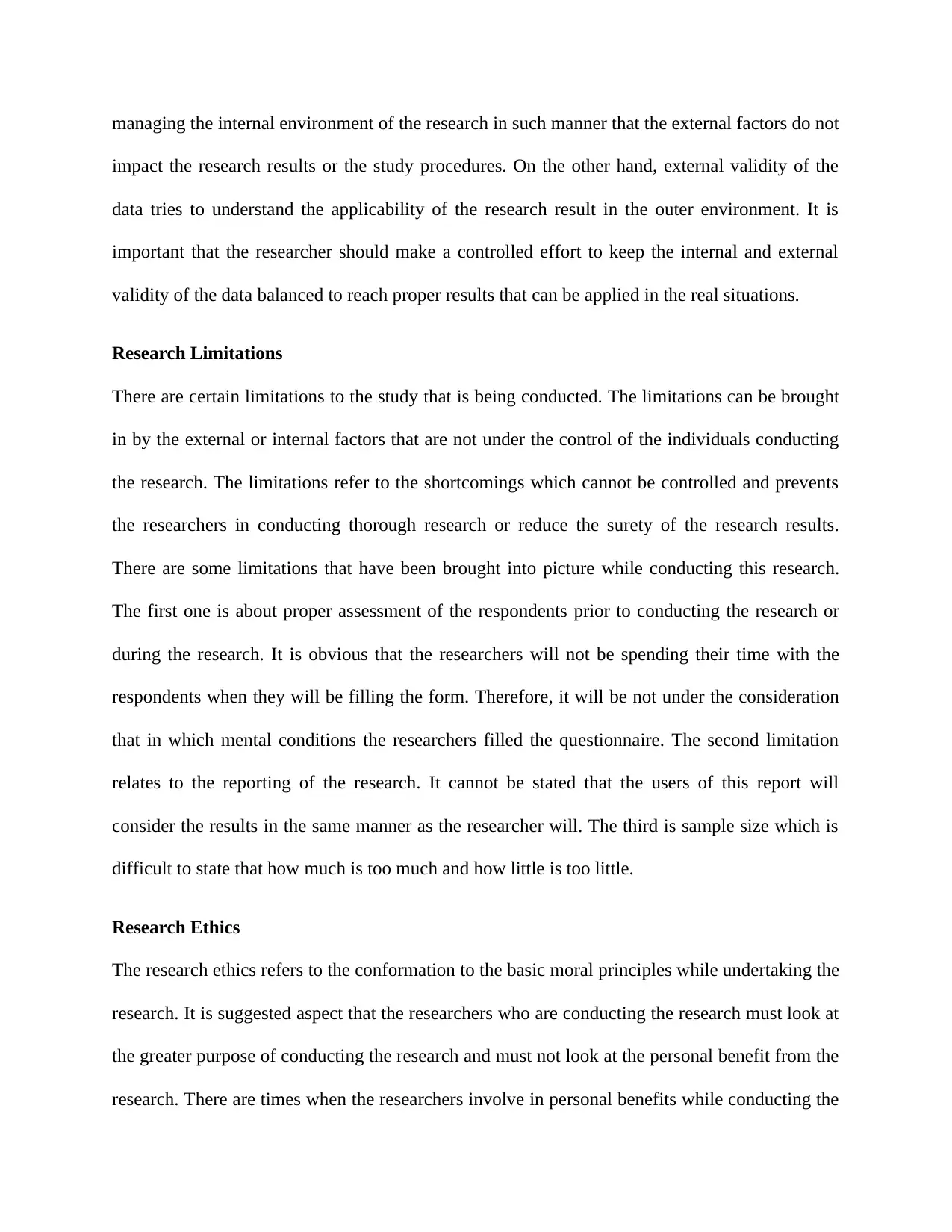
managing the internal environment of the research in such manner that the external factors do not
impact the research results or the study procedures. On the other hand, external validity of the
data tries to understand the applicability of the research result in the outer environment. It is
important that the researcher should make a controlled effort to keep the internal and external
validity of the data balanced to reach proper results that can be applied in the real situations.
Research Limitations
There are certain limitations to the study that is being conducted. The limitations can be brought
in by the external or internal factors that are not under the control of the individuals conducting
the research. The limitations refer to the shortcomings which cannot be controlled and prevents
the researchers in conducting thorough research or reduce the surety of the research results.
There are some limitations that have been brought into picture while conducting this research.
The first one is about proper assessment of the respondents prior to conducting the research or
during the research. It is obvious that the researchers will not be spending their time with the
respondents when they will be filling the form. Therefore, it will be not under the consideration
that in which mental conditions the researchers filled the questionnaire. The second limitation
relates to the reporting of the research. It cannot be stated that the users of this report will
consider the results in the same manner as the researcher will. The third is sample size which is
difficult to state that how much is too much and how little is too little.
Research Ethics
The research ethics refers to the conformation to the basic moral principles while undertaking the
research. It is suggested aspect that the researchers who are conducting the research must look at
the greater purpose of conducting the research and must not look at the personal benefit from the
research. There are times when the researchers involve in personal benefits while conducting the
impact the research results or the study procedures. On the other hand, external validity of the
data tries to understand the applicability of the research result in the outer environment. It is
important that the researcher should make a controlled effort to keep the internal and external
validity of the data balanced to reach proper results that can be applied in the real situations.
Research Limitations
There are certain limitations to the study that is being conducted. The limitations can be brought
in by the external or internal factors that are not under the control of the individuals conducting
the research. The limitations refer to the shortcomings which cannot be controlled and prevents
the researchers in conducting thorough research or reduce the surety of the research results.
There are some limitations that have been brought into picture while conducting this research.
The first one is about proper assessment of the respondents prior to conducting the research or
during the research. It is obvious that the researchers will not be spending their time with the
respondents when they will be filling the form. Therefore, it will be not under the consideration
that in which mental conditions the researchers filled the questionnaire. The second limitation
relates to the reporting of the research. It cannot be stated that the users of this report will
consider the results in the same manner as the researcher will. The third is sample size which is
difficult to state that how much is too much and how little is too little.
Research Ethics
The research ethics refers to the conformation to the basic moral principles while undertaking the
research. It is suggested aspect that the researchers who are conducting the research must look at
the greater purpose of conducting the research and must not look at the personal benefit from the
research. There are times when the researchers involve in personal benefits while conducting the
⊘ This is a preview!⊘
Do you want full access?
Subscribe today to unlock all pages.

Trusted by 1+ million students worldwide
1 out of 32
Related Documents
Your All-in-One AI-Powered Toolkit for Academic Success.
+13062052269
info@desklib.com
Available 24*7 on WhatsApp / Email
![[object Object]](/_next/static/media/star-bottom.7253800d.svg)
Unlock your academic potential
Copyright © 2020–2025 A2Z Services. All Rights Reserved. Developed and managed by ZUCOL.





